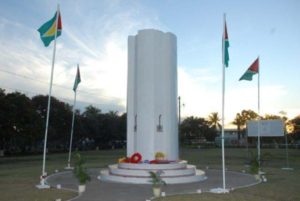
June 16, 2018 will mark 70 years since the shooting to death of five sugar workers at Enmore, East Coast Demerara. The five – Rambarran, Pooran, Lallabagee, Surajballi and Harry – became known as the Enmore Martyrs following their deaths on June 16, 1948. Martyrs, by its definition, connotes the ultimate sacrifice that one selflessly makes generally for the betterment of others and country. In this case, these martyrs paid with their dear lives for the cause to better working conditions for sugar workers.
The arduous task of harvesting cane manually is well known. One of the workers’ contentions was the added burden of having to cut the cane, to then loading it into punts some distance away (referred to as the “cut and load” system). This back-breaking method, which was introduced in 1945, was clearly unpopular with the workers who demanded that it be replaced with “cut and drop”; they cut and others load.
At the time, social and economic conditions were less than desirable. That saddled workers with poor wages and living conditions on the estates. They also wanted, the then Guyana Industrial Workers Union, (GIWU), to be recognised as the union to bargain for them. In their minds, these were justifiable demands and having been unable to have them met, they naturally resorted to strike action in April of 1948.
The use of scabs to fill the void the strike created did not resolve the sugar producers’ dilemma. As production became seriously affected, they introduced drastic measures in an effort to force the striking workers to comply. Having felt betrayed by the union that represented them, the Man Power Citizen’s Association, (MPCA), the situation exacerbated and ultimately led to what transpired on that fateful day of June 16, 1948.
The context of that incident must not be lost. They were simple workers who unselfishly stood up to the ‘massas’ demanding that their welfare not be ignored. After all, they were contributing significantly to the enrichment of the masters who seemed totally unconcerned of the plight the workers were forced to endure. Had those striking workers been successful through the actions they took, all would have benefited from the much desired improvement of conditions.
Tragically, they paid with their lives and it resonated across the country. That incident was not just a pivotal moment in our nation’s history for what had happened, but what it eventually led to in the context of our politics. It profoundly impacted a young Dr Cheddi Jagan. The strikes, prior to the shooting, were supported by the Political Affairs Committee (PAC), which he and his wife, Janet, were founders. They helped to raise funds and operated soup kitchens to assist the striking workers and their families.
The deaths of the five workers touched him in many ways and at the gravesite on the day of their funerals, he silently pledged to dedicate his life to the cause of the Guyanese people; to free them from bondage and exploitation. It was that pledge that propelled and guided him in his relentless struggles for an independent Guyana and championing the rights of workers. He founded the People’s Progressive Party (PPP) in 1950 which led subsequent struggles culminating in the return to democracy in 1992.
While the five workers died during their quest for betterment, their sacrifices further heightened awareness of what they were experiencing, galvanised sentiments, fuelled hope and helped to intensify the struggle not just for improved working conditions for sugar workers, but for all Guyanese. However, following their struggles for advancement on the sugar belt, 70 years after, one can venture to question the seeming erosion of the value of their sacrifices by the powers that be.
Within the past two years, a number of sugar estates were closed, plunging thousands of workers into unemployment. The callous manner in which it was done without any apparent consideration for impact assessment studies and alternative employment, was interpreted as been uncaring to the workers and the dire circumstances it created. As it is, these unemployed workers continue to experience tremendous difficulties to provide for their families including the provision of education for children.
The social impact of this mass termination continues to ripple across and beyond the sugar belt crippling local economies and drastically reversing the gains made in living standards. Many families are hard-pressed to provide three basic but modest meals per day as pressure mounts on the recognised breadwinner. While the scenarios may be different to what transpired 70 years ago, there are frightening similarities foremost being the struggle for a better life and to adequately provide for families.
Today, the harsh reality is that thousands of affected sugar workers daily face a monumental task to provide as uncertainty and despondency engulfs to the point of strangulation. Given what is unfolding now, not just for sugar workers, but for all who are further burdened by the continually worsening economic situation and as quality of life declines, the question of whether the Enmore Martyrs’ sacrifices are in vain, seems apt for debate. While such sacrifices are always valued and epitomises a beacon of hope and pillars of strength, the answers of the workers currently affected, may unavoidably be a foregone conclusion. Déjà vu?



